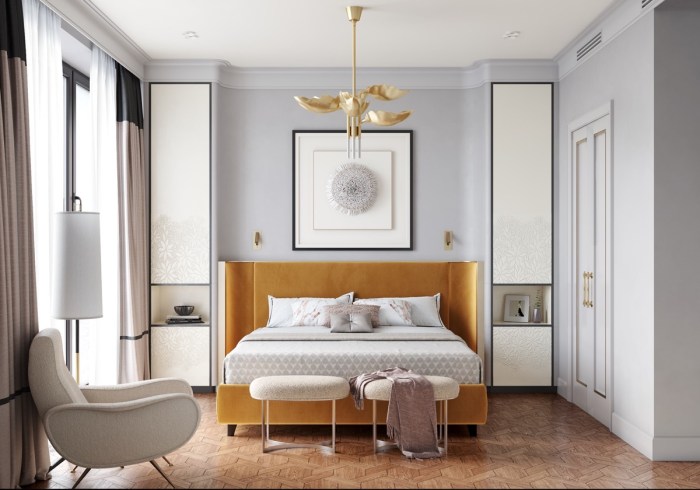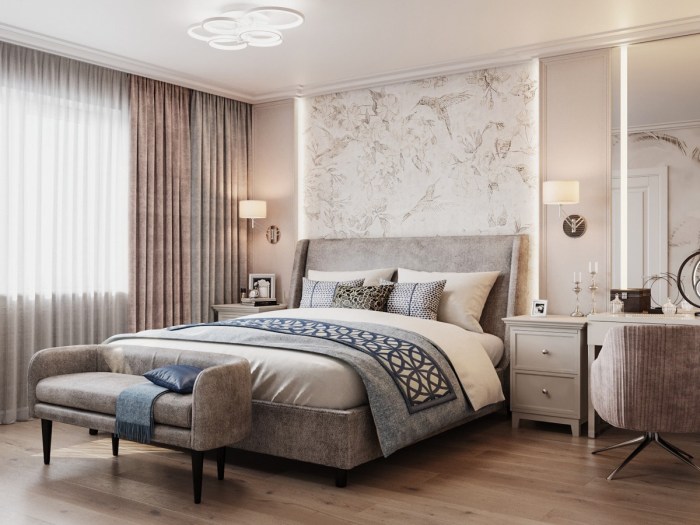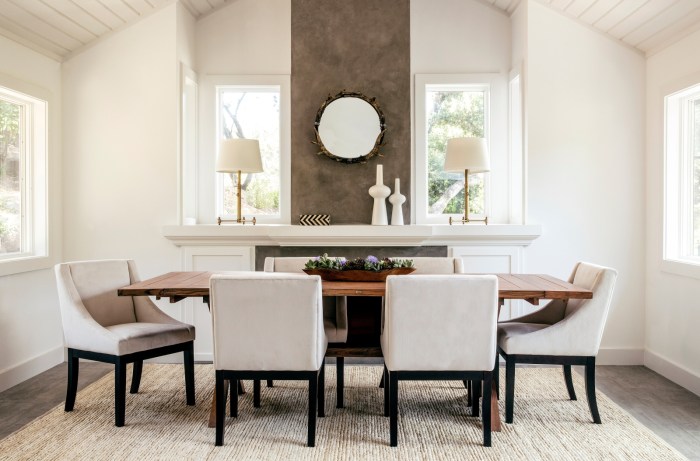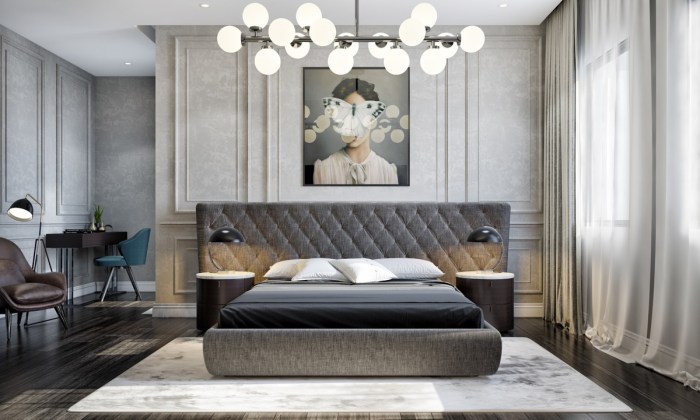Transitional Style: Bridging Classic and Contemporary Design invites you to explore a captivating fusion of design elements that seamlessly blends the timeless elegance of traditional styles with the sleek sophistication of modern aesthetics. Prepare to embark on a journey where the past and present harmoniously intertwine, creating spaces that exude both comfort and style.
Delve into the essence of transitional style, uncovering its defining characteristics and gaining practical insights into how traditional and modern elements can be masterfully combined to achieve a cohesive and inviting ambiance. Discover the secrets of selecting harmonious color palettes, incorporating patterns that bridge the gap between eras, and choosing furniture and decor that effortlessly complement each other.
Defining Transitional Style
Transitional style is a harmonious blend of classic and contemporary design elements. It seamlessly merges traditional elegance with modern functionality, creating timeless and sophisticated spaces.
Transitional interiors feature a balance of ornate details and clean lines, with a focus on comfort and practicality. Classic elements, such as crown molding and decorative hardware, are paired with modern pieces, such as sleek sofas and geometric patterns.
Key Characteristics
- Neutral Color Palette:Transitional spaces often feature a neutral color palette, with whites, creams, and grays providing a backdrop for both classic and modern elements.
- Mixed Materials:Transitional interiors combine different materials, such as wood, metal, and glass, to create a layered and eclectic look.
- Curved and Straight Lines:Transitional style embraces both curved and straight lines, with traditional curves often softened by modern straight lines.
- Comfortable Furniture:Transitional furniture is designed for both comfort and style, with classic sofas and armchairs upholstered in modern fabrics.
Color Palettes and Patterns in Transitional Style

Transitional design embraces a harmonious blend of classic and contemporary elements, and this extends to its color palettes and patterns. Neutrals, pastels, and bold accents create a sophisticated and inviting atmosphere, while geometric prints and floral motifs add a touch of visual interest.
Color Palettes
Neutral colors, such as white, beige, and gray, provide a timeless foundation for transitional interiors. They allow bolder hues and patterns to take center stage without overwhelming the space. Pastels, such as blush pink, soft blue, and lavender, introduce a subtle pop of color while maintaining a sense of serenity.
Bold accents, such as navy, emerald green, or mustard yellow, can be used to create focal points or add a touch of drama.
Patterns
Transitional patterns combine classic and contemporary motifs to create a unique and cohesive look. Geometric prints, such as stripes, chevrons, and polka dots, add a modern touch, while floral motifs, such as damask, toile, and chintz, bring a touch of traditional elegance.
Mixing and matching patterns in different scales and colors can create a visually dynamic and eclectic space.
Furniture and Decor in Transitional Style

Transitional style embraces a harmonious blend of traditional and modern elements in furniture and decor. It’s a style that combines the warmth and elegance of classic pieces with the clean lines and functionality of contemporary design.
When choosing furniture for a transitional space, opt for pieces that seamlessly merge traditional and modern lines. Upholstered sofas with clean silhouettes and tailored details create a sophisticated and inviting ambiance. Look for pieces with classic shapes and proportions, such as wingback chairs or Chesterfield sofas, but with contemporary fabrics and finishes.
Incorporating Decorative Accessories, Transitional Style: Bridging Classic and Contemporary Design
Decorative accessories play a crucial role in adding both warmth and a touch of modernity to a transitional space. Vintage artwork, with its rich colors and intricate details, adds a touch of history and character. Contemporary lighting fixtures, with their sleek lines and innovative designs, bring a touch of modernity to the space.
By carefully selecting and combining these elements, you can create a cohesive and visually appealing transitional interior.
Lighting in Transitional Style

Lighting plays a crucial role in creating a balanced and inviting transitional space. By combining traditional and modern lighting fixtures, you can achieve a cohesive and harmonious atmosphere.
Traditional lighting fixtures, such as chandeliers and sconces, add a touch of elegance and sophistication to a room. Their intricate designs and warm, ambient light create a cozy and welcoming ambiance. Modern pendant lights and recessed lighting, on the other hand, offer clean lines, geometric shapes, and bright, focused illumination.
These fixtures bring a contemporary touch to the space and help to define different areas of the room.
Mixing Traditional and Modern Lighting
When mixing traditional and modern lighting, it’s important to consider the scale, style, and finish of the fixtures. Traditional chandeliers, for example, are typically larger and more ornate than modern pendant lights. To create a balanced look, pair a traditional chandelier with a modern sconce or pendant light in a smaller size.
Similarly, if you choose a modern pendant light with a bold, geometric design, opt for a traditional sconce with a more subdued finish.
Another way to mix traditional and modern lighting is to use different types of light bulbs. Traditional incandescent bulbs emit a warm, yellow light, while modern LED bulbs produce a cooler, white light. By combining these different types of bulbs, you can create a layered lighting scheme that provides both ambient and task lighting.
Creating a Cohesive Transitional Space: Transitional Style: Bridging Classic And Contemporary Design

Creating a cohesive transitional space involves seamlessly blending classic and contemporary elements to achieve a harmonious and inviting atmosphere. Here’s a step-by-step guide to help you create a cohesive transitional space:
1. Start with a Neutral Base: Choose a neutral color palette for walls, floors, and large furniture pieces. This will provide a backdrop that allows you to layer on different elements without overwhelming the space.
2. Mix and Match Styles: Don’t be afraid to mix classic and contemporary pieces. For example, pair a traditional sofa with a modern coffee table or a vintage rug with a sleek dining table.
3. Use Accessories and Artwork: Accessories and artwork can help tie a room together and create a cohesive flow. Choose pieces that reflect both classic and contemporary styles, such as a vintage mirror with a modern frame or a contemporary painting with a classic subject.
4. Pay Attention to Lighting: Lighting can greatly impact the atmosphere of a room. Use a combination of natural and artificial light to create a warm and inviting space. Consider adding dimmers to adjust the lighting levels depending on the occasion.
5. Don’t Overcrowd: Avoid overcrowding your space with too much furniture or accessories. Leave some open space to create a sense of balance and flow.
6. Create Focal Points: Every room needs a focal point, which could be a fireplace, a large window, or a piece of artwork. Arrange your furniture and accessories around the focal point to create a sense of visual interest.
7. Consider Scale and Proportion: When mixing different styles, pay attention to the scale and proportion of the pieces. Make sure that the larger pieces are balanced by smaller ones to create a visually pleasing arrangement.
8. Don’t Be Afraid to Experiment: Creating a cohesive transitional space is an ongoing process. Don’t be afraid to experiment with different combinations of furniture, accessories, and artwork until you find what works best for your space.
Last Word

As you embrace the principles of transitional style, you’ll unlock the potential to create spaces that transcend time, reflecting both your appreciation for the classics and your desire for a touch of contemporary flair. Whether you’re seeking inspiration for a complete home makeover or simply want to add a touch of timeless elegance to your existing decor, this guide will equip you with the knowledge and confidence to achieve your design aspirations.
General Inquiries
What are the key characteristics of transitional style?
Transitional style is defined by its ability to blend traditional and modern elements, creating a harmonious balance between the two. It often features clean lines and simple silhouettes combined with warm, inviting textures and classic details.
How can I incorporate transitional style into my home?
Start by choosing a neutral color palette and adding pops of color through accessories and artwork. Mix and match traditional and modern furniture pieces, and don’t be afraid to experiment with different patterns and textures to create a layered and visually interesting space.
What are some tips for choosing furniture for a transitional style space?
Look for furniture that combines classic lines with modern details, such as upholstered sofas with clean silhouettes and tufted cushions. Choose pieces that are both comfortable and stylish, and don’t be afraid to mix and match different styles to create a unique look.
